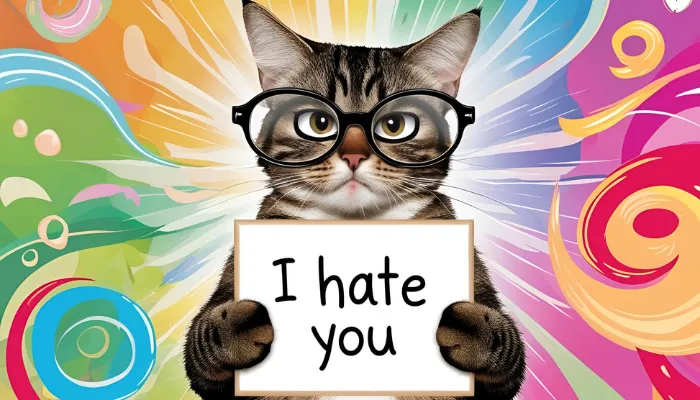How Do I Say “I Hate You” in Cat Translator? If by chance you have ever gotten scratched at, or even been hissed at or ignored by your cat, you may be wondering how you can express your annoyance back in their language. Cats have three primary means of communication, and these are body language, vocal sounds and behavior, so adjusting human emotions to their style is quite difficult.
Through the use of a Cat Translator, you hope to decipher their signals to attempt to communicate your emotions, even though “hate” is a difficult-to-understand concept for cats. Let’s take a look at how sentiments are constructed in cats, and how you can demonstrate yours.

Can Cats Understand Human Emotions?
Cats are keenly observed and they can note human moods. They may not fully comprehend the word “hate” but they can certainly tell when “hate” is being expressed through gestures and tone of voice.
Ways Cats Detect Your Emotions:
- Tone of Voice: Cats react differently to soft versus harsh tones.
- Body Language: Stiff movements or avoiding eye contact may signal discomfort.
- Scent: Stress and anger release specific pheromones that cats can detect.
Cats may not understand words, but they sense your emotions through tone, body language, and scent. Your feline friend knows more about your mood than you think!
How to Show Displeasure to Your Cat?
Since cats communicate differently than humans, expressing dislike requires non-verbal cues. Here are a few ways you can show your discontent to your cat in a way they understand:
1. Use Vocal Cues
- Hissing mimics feline aggression.
- A short, firm “No” can indicate displeasure.
- Avoid yelling—cats respond better to a firm but calm tone.
2. Adjust Your Body Language
- Walk away when they demand attention.
- Avoid direct eye contact, as this can be seen as threatening.
- Turn your back to them to show rejection.
3. Use Controlled Ignorance
- Cats dislike being ignored.
- Withhold affection for a short period.
- Do not give treats or playtime immediately after they misbehave.
Cats understand actions more than words, so your body language and tone speak volumes. How Do I Say “I Hate You” in Cat Translator? Subtle cues send the message loud and clear!
Do Cats Know the Concept of Hate?
Unlike humans, cats don’t experience complex emotions like hate. Instead, they react to situations based on comfort, security, and routine. If a cat appears to “hate” you, it’s usually due to fear, discomfort, or past trauma.
Signs a Cat is Unhappy With You:
| Sign | Meaning |
|---|---|
| Hissing or Growling | Fear or aggression |
| Tail Flicking | Irritation or annoyance |
| Avoidance | Discomfort or distrust |
| Flattened Ears | Stress or fear |
Cats don’t feel hate, but their actions reveal fear, discomfort, or distrust in subtle ways.
Ways to Show Your Cat You’re Upset
If you’re truly set on showing a cat that you’re upset, consider these methods:
- Short, low sounds – Imitating feline growls can express irritation.
- Slow blinking at them but looking away – Signals disinterest.
- Leaving the room abruptly – Mimics feline behavior of dismissing others.
- Blocking access to their favorite spot – Shows dominance in cat terms.
- Not engaging in play – A clear sign of displeasure for attention-seeking cats.
Cats understand actions more than words, so subtle cues express your feelings best. How Do I Say “I Hate You” in Cat Translator? Distance and disinterest send a clear message!
Is It Okay to Show Displeasure to a Cat?
Yes, but in a controlled and gentle way. Unlike dogs, cats do not respond well to punishment or raised voices. Instead, they learn through association and repetition.
Healthy Ways to Show Your Cat You’re Upset:
- Time-outs: Briefly leave the room when they misbehave.
- Withholding treats: Reinforce positive behavior instead.
- Ignoring them: Works especially well for overly needy cats.
Cats learn best through gentle signals, not punishment—patience strengthens your bond.
Advanced Ways to Show Displeasure to Your Cat
If your cat is misbehaving, here are a few advanced techniques to signal displeasure:
- Mimic their behavior: A slow-turn head away signals rejection.
- Lower your energy: Cats sense frustration and may react aggressively.
- Avoid petting: A break from affection can signal disappointment.
- Use their language: A firm, low “Mrrr” can mimic a warning sound.
Cats pick up on subtle cues, so actions speak louder than words. How Do I Say “I Hate You” in Cat Translator? Distance, tone, and rejection send the message!
What Should You Do Instead of Saying “I Hate You”?
Rather than expressing frustration, try fostering a better relationship with your cat.
Steps to Improve Bonding:
- Understand Their Behavior: Recognize why they act out.
- Give Them Space: Cats need personal time.
- Use Positive Reinforcement: Reward good behavior.
- Communicate in Their Language: Slow blinks and soft tones work best.
Building trust beats frustration, strengthening your bond the right way. How Do I Say “I Hate You” in Cat Translator? Understanding and patience speak louder than words!
Conclusion
How Do I Say “I Hate You” in Cat Translator? While cats don’t grasp the concept of hate, they understand body language, tone, and behavior. Expressing displeasure effectively involves ignoring, using low vocal tones, or mimicking cat behaviors instead of verbalizing frustration. The key is to maintain gentle, consistent communication to keep your bond strong. Cats may not “hate” you back, but they will respond accordingly to how you treat them.
